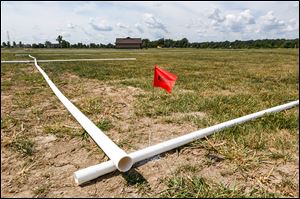
Stormwater project OK’d for Oregon complex
7/21/2014
The drainage swales of the South Athletic Complex in Oregon will get ‘bioretention’ cells to handle rainwater runoff.
The parking lots at Oregon’s South Athletic Complex, off the Starr Avenue Extension, are going green.
City Council last week approved bids from two contractors for construction of four “bioretention” cells in the parking lot drainage swales that will trap sediment and nutrients in rainwater runoff before they are conducted to the city’s wastewater treatment plant and eventually to Maumee Bay.
Paul Roman, the city’s service director, described the project as small — costing just under $105,000 — but important, because it demonstrates to the public and businesses Oregon’s involvement in improving the environment.
“Overall we do a lot of mitigation projects,” he said. “This is educational, and we can use it as an example to developers.”
Another benefit, he noted, was that the runoff relayed to the treatment plant would be cleaner.
The project will be 100 percent funded by an Ohio Environmental Protection Agency grant awarded in conjunction with the Lucas County Stormwater Improvement Fund. It will consist of the four bioretention cells containing a mix of sand and mulch with plantings on top.
Mr. Roman said he expected excavation work to be started in the next few weeks, with planting to be done in the fall.
The cells will be 4 feet deep, 300 feet long, and 30 feet wide, and act as a filter for runoff from the parking lots. A 6-inch tile beneath them will convey water to the treatment plant, which discharges into Wolf Creek, which then drains into Lake Erie.
Bids for the project were opened July 1. Council hired Ropper Construction of Willard, Ohio, for $44,755, for the excavation work. Landscape Design by Moritz of Oregon will be paid $19,606.10 for the landscaping part of the project.
The engineered soil mix filling the cells will be bought from Woodville Nursery for $23,525. Other costs are $10,000 for the loading and hauling of the soil mix, and $5,000 for education, which includes instruction on the benefits of sediment reduction for Clay High School students.
Oregon’s soil is largely soft clay, and “our number one pollutant is sediment,” Mr. Roman said.
The final project is a scaled-down version of the original, which called for five bioretention cells. The number was reduced to stay within the $105,758 grant amount. The city also held down costs by obtaining a better price for the soil mix than the contractors bidding the project and by hauling the soil mix itself.
Contact Carl Ryan at: carlryan@theblade.com or 419-724-6095.